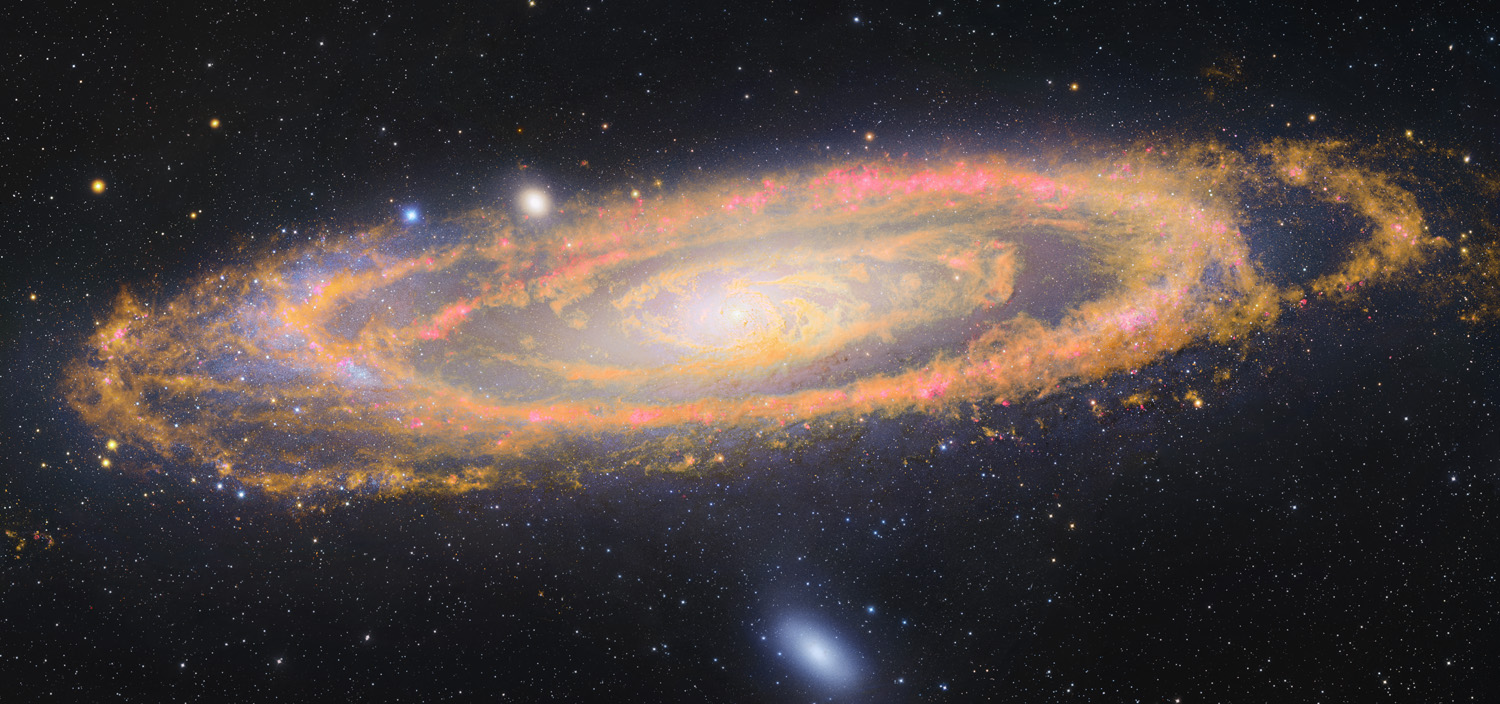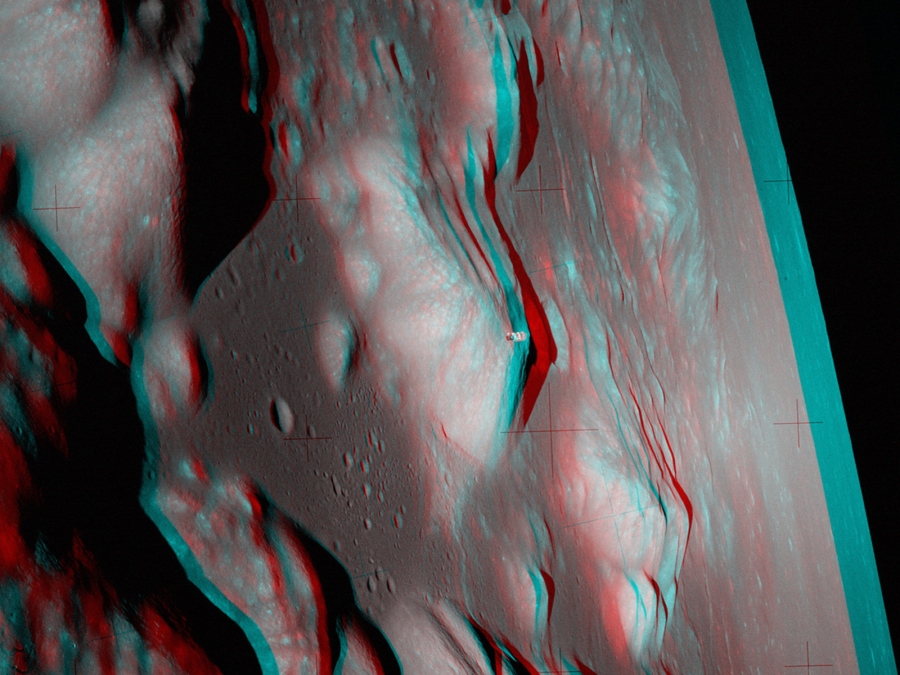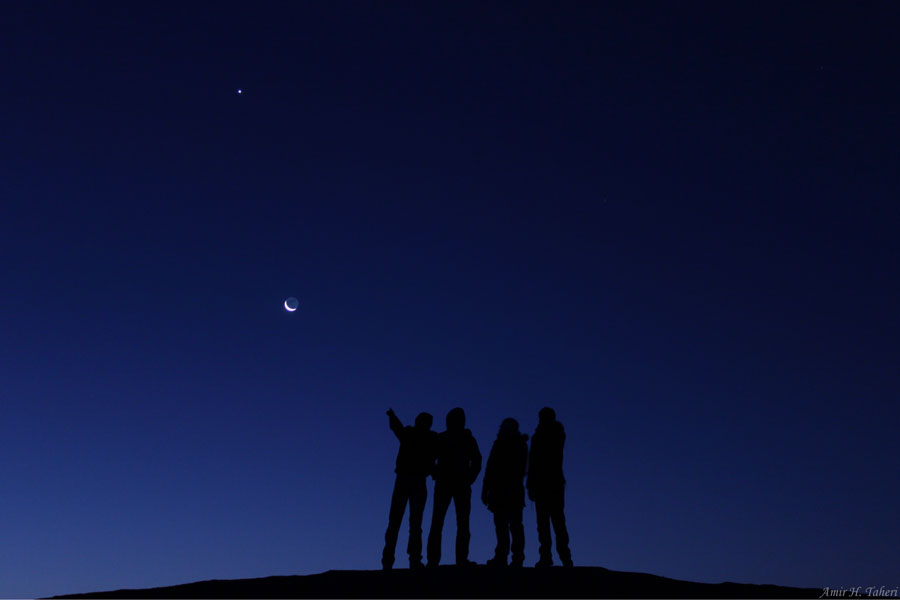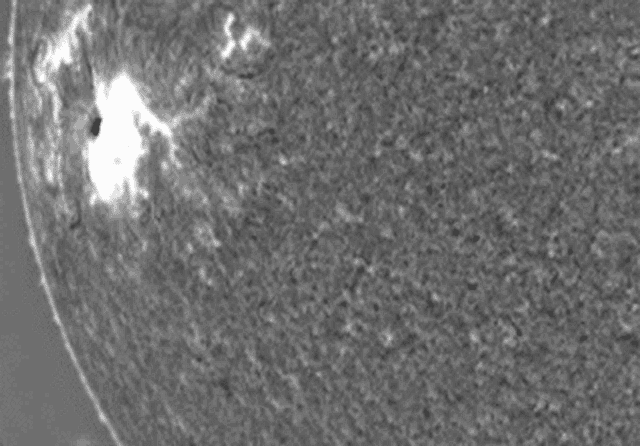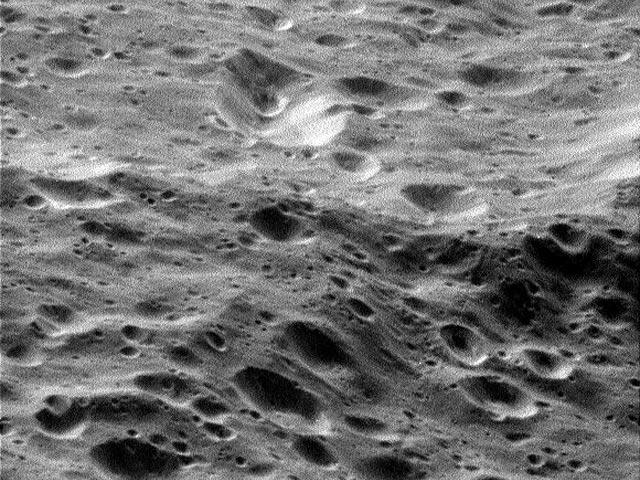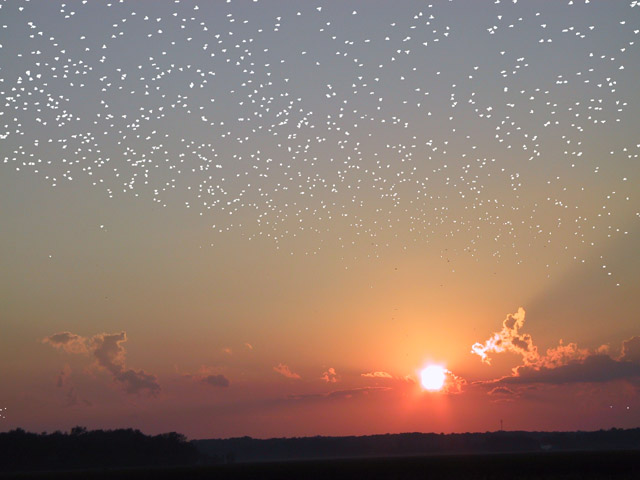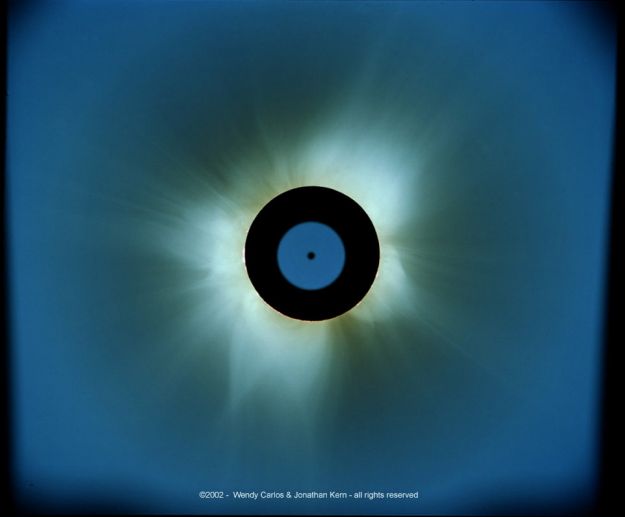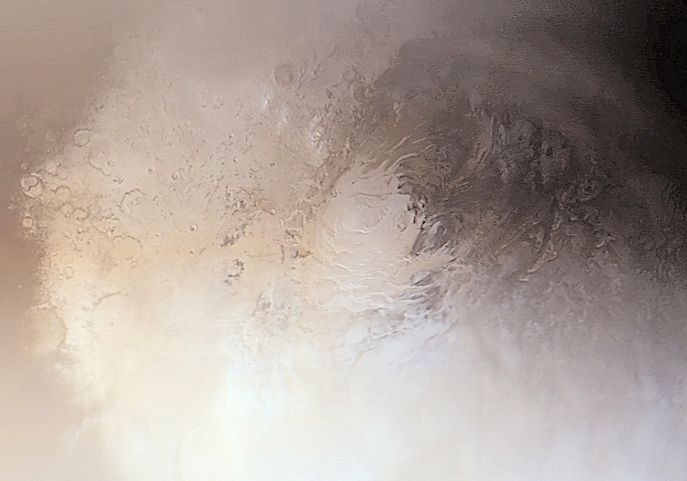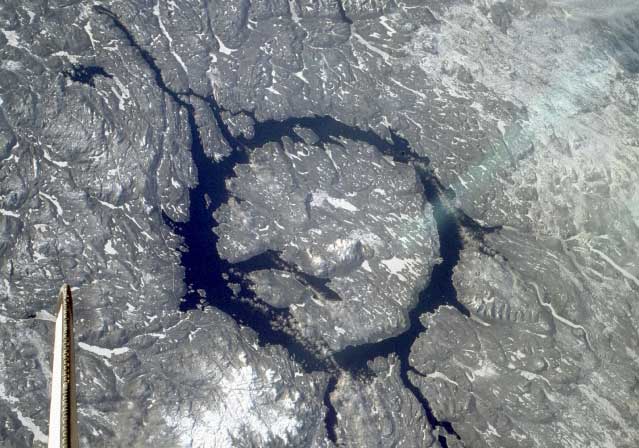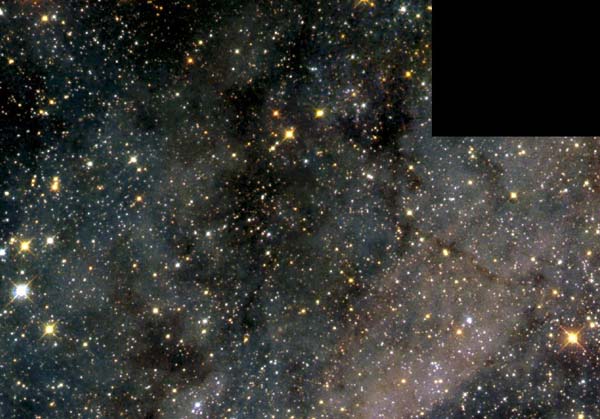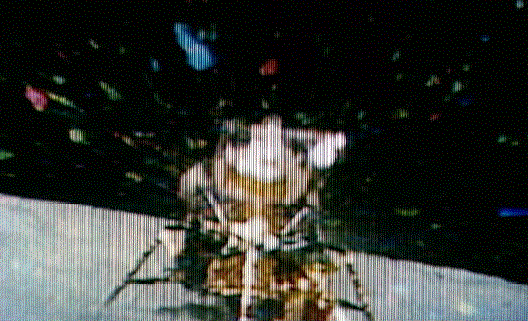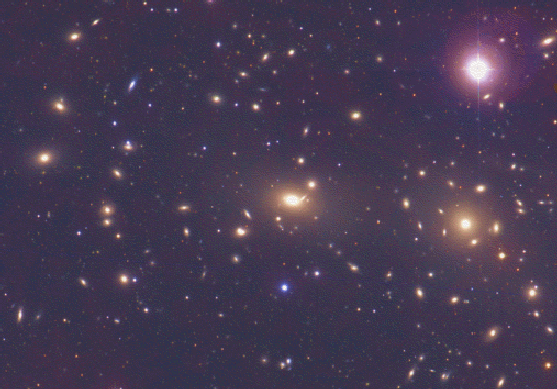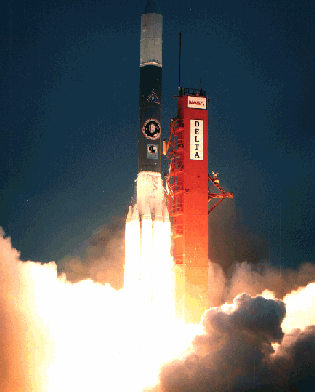| << Previous | Index | Next >> |
2014
2013 The annual Geminid meteor shower is raining down on planet Earth this week. And despite the waxing gibbous moonlight, the reliable Geminids should be enjoyable tonight (night of December 13/14) near the shower's peak. Recorded near last year's peak in the early hours of December 14, 2012, this skyscape captures many of Gemini's lovely shooting stars. The careful composite of exposures was made during a three hour period overlooking the Dashanbao Wetlands in central China. Dark skies above are shared with bright Jupiter (right), Orion, (right of center) and the faint band of the Milky Way. The shower's radiant in the constellation Gemini, the apparent source of all the meteor streaks, lies just above the top of the frame. Dust swept up from the orbit of active asteroid 3200 Phaethon, Gemini's meteors enter the atmosphere traveling at about 22 kilometers per second.
2012 Get out your red/blue glasses and check out this awesome stereo view of another world. The scene was recorded by Apollo 17 mission commander Eugene Cernan on December 11, 1972, one orbit before descending to land on the Moon. The stereo anaglyph was assembled from two photographs (AS17-147-22465, AS17-147-22466) captured from his vantage point on board the Lunar Module Challenger as he and Dr. Harrison Schmitt flew over Apollo 17's landing site in the Taurus-Littrow Valley. The broad, sunlit face of the mountain dubbed South Massif rises near the center of the frame, above the dark floor of Taurus-Littrow to its left. Beyond the mountains, toward the lunar limb, lies the Moon's Mare Serenitatis. Piloted by Ron Evans, the Command Module America is visible in orbit in the foreground against the South Massif's peak.
2011 Strange shapes and textures can be found in neighborhood of the Cone Nebula. The unusual shapes originate from fine interstellar dust reacting in complex ways with the energetic light and hot gas being expelled by the young stars. The brightest star on the right of the above picture is S Mon, while the region just below it has been nicknamed the Fox Fur Nebula for its color and structure. The blue glow directly surrounding S Mon results from reflection, where neighboring dust reflects light from the bright star. The red glow that encompasses the whole region results not only from dust reflection but also emission from hydrogen gas ionized by starlight. S Mon is part of a young open cluster of stars named NGC 2264, located about 2500 light years away toward the constellation of the Unicorn (Monoceros). The origin of the mysterious geometric Cone Nebula, visible on the far left, remains a mystery.
2010 Have you contemplated your sky recently? Tonight will be a good one for midnight meditators at many northerly locations as meteors from the Geminids meteor shower will frequently streak through. The Geminds meteor shower has slowly been building to a crescendo and should peak tonight. Pictured above ten days ago, a group of celestial sightseers in the Maranjab Desert in Iran, were treated to a dark and wondrous pre-dawn sky that contained the planet Venus and a crescent Moon. Tonight Mars and Mercury should be visible just above the southwestern horizon at sunset, while the first quarter Moon will set around midnight.
2009 Gliding silently through the outer Solar System, the Voyager 2 spacecraft camera captured Neptune and Triton together in crescent phase in 1989. The above picture of the gas giant planet and its cloudy moon was taken from behind just after closest approach. It could not have been taken from Earth because Neptune never shows a crescent phase to sunward Earth. The unusual vantage point also robs Neptune of its familiar blue hue, as sunlight seen from here is scattered forward, and so is reddened like the setting Sun. Neptune is smaller but more massive than Uranus, has several dark rings, and emits more light than it receives from the Sun.
2008 On the night of December 13, 1908, 100 years ago today, the 60-inch diameter reflecting telescope of Mount Wilson Observatory was first tested on the stars. It became the first successful large reflecting telescope. The 60-inch reflector demonstrated a scalable design that used a mirror to gather faint starlight, rather than a large and more difficult to support lens, becoming the granddaddy of all, even larger, modern telescopes. Now-famous astronomers, including Harlow Shapley and Edwin Hubble, were able to use the 60-inch reflector to embark on a new kind of exploration of stars, distant galaxies, and the nature of the universe. Still looking skyward a century after its first light, the historic telescope is seen here pointing toward one of the most recognizable celestial events of 2008, the remarkable conjunction of Moon, Venus, and Jupiter.
2007 The orange star centered in this remarkable telescopic skyview is T Tauri, prototype of the class of T Tauri variable stars. Nearby it is a dusty yellow cosmic cloud historically known as Hind's Variable Nebula (NGC 1555/1554). Over 400 light-years away, at the edge of a molecular cloud, both star and nebula are seen to vary significantly in brightness but not necessarily at the same time, adding to the mystery of the intriguing region. T Tauri stars are now generally recognized as young (less than a few million years old), sun-like stars still in the early stages of formation. To further complicate the picture, infrared observations indicate that T Tauri itself is part of a multiple system and suggest that the associated Hind's Nebula may also contain a very young stellar object. The dramatic color image spans about 4 light-years at the estimated distance of T Tauri.
2006 Tsunamis this large don't happen on Earth. One week ago, a large solar flare from an Earth-sized sunspot produced a tsunami-type shock wave that was spectacular even for the Sun. Pictured above, the tsunami wave was captured moving out from active region AR 10930 by the Optical Solar Patrol Network (OSPAN) telescope in New Mexico, USA. The resulting shock wave, known technically as a Moreton wave, compressed and heated up gasses including hydrogen in the photosphere of the Sun, causing a momentarily brighter glow. The above image was taken in a very specific red color emitted exclusively by hydrogen gas. The rampaging tsunami took out some active filaments on the Sun, although many re-established themselves later. The solar tsunami spread at nearly one million kilometers per hour, and circled the entire Sun in a matter of minutes.
2005 What does the surface of Saturn's moon Rhea look like? To help find out, the robot Cassini spacecraft currently orbiting Saturn was directed to fly right past the second largest moon of the gas giant planet late last month. Pictured above is an image taken only 620 kilometers above Rhea's icy surface, spanning about 90 kilometers. The rim of an old crater crosses the middle of the image, with many smaller and younger craters scattered throughout. A linear depression -- possibly a tectonic fault -- is visible toward the right, crossing the likely loose material that composes Rhea's surface regolith. The origins of many features on Rhea are currently unexplained and being researched.
2004 A comet discovered only this summer is brightening quickly and already visible to the unaided eye. Comet C/2004 Q2 (Machholz) is currently best visible in Earth's Southern Hemisphere where some observers report it brighter than magnitude 5. The comet is moving rapidly to northern skies and should continue to brighten until early January. By coincidence, Comet Machholz will be easy to view as it will be nearly opposite the Sun when appearing its brightest. How bright Comet Machholz will become then remains uncertain, but it will surely stay in northern skies for much of 2005, even approaching Polaris in early March. Pictured above, Comet Machholz was captured in early December already sporting a bright surrounding coma, a white oblong dust tail fading off toward the bottom, and a long wispy ion tail toward the right with a kink near the end.
2003 Only a few stars can be found within ten light-years of our lonely Sun, situated near an outer spiral arm of the Milky Way galaxy. But if the Sun were found within one of our galaxy's star clusters, thousands of stars might occupy a similar space. What would the night sky look like in such a densely packed stellar neighborhood? When Roger Hopkins took this picture at the Montezuma National Wildlife Refuge in the Finger Lakes region of western New York, USA, he was struck by this same notion. Appropriately, he had photographed a flock of starlings against the backdrop of a serene sunset. He then manipulated the image so that the black bird silhouettes were changed to white. The final picture dramatically suggests the tantalizing spectacle of approaching night in crowded skies above a cluster star world.
2002 During a total solar eclipse, the Sun's extensive outer atmosphere or corona is an awesome and inspirational sight. Yet the subtle shades and shimmering features of the corona that engage the eye span a brightness range of over 10,000 to 1, making them notoriously difficult to capture in a photograph. Still, this single five second exposure comes very close to revealing the crown of the Sun in all its glory. The color picture was taken with a specially built coronal camera and telescope during the December 4th total eclipse from Messina, South Africa. The camera's design incorporates a precisely made filter whose density, or ability to block light, decreases markedly with distance from the filter center, compensating for the difference between the brighter inner portion of the corona at the Sun's edge and the much fainter outer regions. The central spot in the image corresponds to a calibration window centered on the eclipsed Sun.
2001 The south pole of Mars is the bright area near the center of the detailed, subtly shaded color image above. Recorded in September of this year by the Mars Global Surveyor (MGS) spacecraft, the picture shows a region surrounding the 400 kilometer wide martian polar cap in the midst of southern hemisphere spring. During this season the ice cap, predominantly layers of frozen carbon dioxide (dry ice) plus some water ice, begins to shrink as the ices change directly from solid to gas (sublimate). Hazy clouds of ice crystals and fog, extend across the bottom of the picture and a darker, more defrosted area is visible at the upper right, near the Red Planet's night side. A wealth of MGS data has allowed changes in the extent and density of the ice cap to be tracked over time. Now, researchers are also reporting indications that, in addition to seasonal changes, overall the martian southern ice cap has been dwindling in recent years -- dramatic evidence of a changing martian climate. At the measured rate, the increasing amount of carbon dioxide released could gradually raise Mars' atmospheric pressure, doubling it over hundreds to thousands of martian years.
2000 The Manicouagan Crater in northern Canada is one of the oldest impact craters known. Formed during a surely tremendous impact about 200 million years ago, the present day terrain supports a 70-kilometer diameter hydroelectric reservoir in the telltale form of an annular lake. The crater itself has been worn away by the passing of glaciers and other erosional processes. Still, the hard rock at the impact site has preserved much of the complex impact structure and so allows scientists a leading case to help understand large impact features on Earth and other Solar System bodies. Also visible above is the vertical fin of the Space Shuttle Columbia from which the picture was taken in 1983.
1999 Stars of many types and colors are visible in this Hubble Space Telescope vista of the Large Magellanic Cloud (LMC). Over 10,000 stars are visible -- the brightest of which are giant stars. Were our Sun 170,000 light-years distant and among these stars, it would hardly be discernable. By contrast, only a few thousand stars are individually visible at night with the unaided eye, and many of these lie within only a few hundred light-years. Typically, the light we see from nearby stars left during the age of our great-grand-parents, while light from LMC stars started its journey before the dawn of recorded human history.
1998 How did the astronauts get back from the Moon? The Lunar Module that landed two astronauts on the Moon actually came apart. The top part containing the astronauts carried additional rocket fuel which allowed it to blast away, leaving the bottom part on the Moon forever. The top part would later meet up with the Command Module and its astronaut pilot, which were continually orbiting the Moon. All would then return to Earth together. The above picture was taken by a robot TV camera left on the Moon by the crew of Apollo 16. The frame above captures the top part of the Lunar Module just at it was blasting off.
1997 Almost every object in the above photograph is a galaxy. The Coma Cluster of Galaxies pictured is one of the densest clusters known - it contains thousands of galaxies. Each of these galaxies house billions of stars - just as our own Milky Way Galaxy does. Although nearby when compared to most other clusters, light from the Coma Cluster still takes hundreds of millions of years to reach us. In fact, the Coma Cluster is so big it takes light millions of years just to go from one side to the other! Most galaxies in Coma and other clusters are ellipticals, while most galaxies outside of clusters are spirals. The nature of Coma's X-ray emission is still being investigated.
1996 Five closely grouped galaxies are visible in this image made using the Kitt Peak National Observatory 2.1 meter telescope. The grouping is commonly known as Stephan's Quintet. Four of the galaxies show essentially the same redshift suggesting that they are at the same distance from us. The large bluish spiral below and left of center actually has a smaller redshift than the others, indicating it is much closer. It is probably a foreground object which happens to lie along the line of sight to the more distant galaxies. Of the four distant galaxies, three seem to be colliding, showing serious distortions due to gravitational tidal forces. The fourth is a normal appearing elliptical galaxy (at the lower right edge of the field). Recent results suggest that collisions play an important role in the life cycles of galaxies.
1995 A Delta rocket is seen being launched in 1988. In use since 1960, Delta rockets have been launched successfully over 200 times. Scientific satellites placed into orbit by a Delta rocket include IUE, COBE, LAGEOS-I, ROSAT, EUVE, GEOTAIL, and WIND. A Delta rocket is scheduled to launch the X-ray Timing Explorer Satellite (XTE) in the very near future. Commercial launches include INMARSAT. Many recent Delta launches have placed Navstar Global Positioning System satellites into orbit. Delta rockets are manufactured for the USAF and NASA by McDonnell Douglas Space Systems Co.
| << Previous | Index | Next >> |
